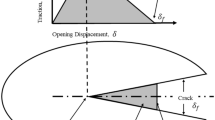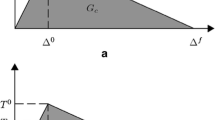Abstract
Two distinct cohesive layer models are developed for numerical simulation of delamination growth in composite layered specimens tested under static loading. One of these designated as the UMAT (user supplied material) model has a small, but finite thickness and the other designated as the UEL (user element) model has zero initial thickness. Crack growth in double cantilever beam specimens as well as in two test configurations of a composite plate carrying some discontinuities subjected to lateral load are studied using the models. It turns out that UEL model, though slightly more involved, is able to predict both crack initiation and large crack growth with sufficient accuracy. The UMAT model too consistently predicts crack initiation, but is unable to predict the crack growth accurately. It gives consistently higher loads for given crack extensions and predicts that the crack growth shuts off prematurely. Careful examination of the stresses in the cohesive layer of the UMAT model, in the upstream of the crack tip indicates that a ‘neck’ develops due to compressive stresses at some distance from the crack tip. Apparently it is the formation of this neck that ‘locks’ the crack from growing and is the cause of the inaccurate results given by the model.
Similar content being viewed by others
References
G. Alfano M.A. Crisfield (2001) ArticleTitleFinite element interface models for the delamination analysis of laminated composites: mechanical and computational issues International Journal for Numerical Methods in Engineering 50 1701–1736
G.I. Barrenblatt (1962) ArticleTitleThe mathematical theory of equilibrium cracks in brittle fracture Advances in Applied Mechanics 7 55–129
M. Charalambides A.J. Kinloch Y. Wang J.G. Williams (1992) ArticleTitleOn the analysis of mixed-mode failure International Journal of Fracture 54 269–291 Occurrence Handle1992IJFr...54..269C
D.S. Dugdale (1960) ArticleTitleYielding of sheets containing slits Journal of Mechanics and Physics of Solids 8 100–104 Occurrence Handle10.1016/0022-5096(60)90013-2
S. El-Sayed S. Sridharan (2001) ArticleTitlePredicting and tracking interlaminar crack growth in composites using a cohesive layer model Composites: Part B 32 545–553 Occurrence Handle10.1016/S1359-8368(01)00030-0
S. El-Sayed S. Sridharan (2002a) ArticleTitlePerformance of a cohesive layer model in the prediction of interfacial crack growth in sandwich beams Journal of Sandwich Structures and Materials 4 31–48
S. El-Sayed S. Sridharan (2002b) ArticleTitleCohesive layer models for predicting delamination growth and crack kinking in sandwich structures International Journal of Fracture 117 63–84 Occurrence Handle10.1023/A:1020930120390
Hibbitt, Karlsson and Sorensen, Inc. (2001). User subroutine to define a material’s mechanical behavior. ABAQUS/Standard/User’s Manual 6.3, 24.2.30.1–24.2.30.14.
Hibbitt, Karlsson and Sorensen, Inc. (1995). Rate of deformation and strain increment. ABAQUS/ Theory Manual 5.5, 1.4.3.1–1.4.3.4.
A. Hillerborg M. Modeer P.-E. Peterson (1976) ArticleTitleAnalysis of crack formation and crack growth in concrete by means of fracture mechanics and finite elements Cement and Concrete Research 6 773–782 Occurrence Handle10.1016/0008-8846(76)90007-7
C.J. Jih (1991) Analysis of delamination in composite laminates under low velocity impact School of Aeronautics and Astronautics, Purdue University IN
C.J. Jih C.T. Sun (1992) ArticleTitlePrediction of delamination in composite laminates subjected to low velocity impact Journal of Composite Materials 27 684–701 Occurrence Handle1993JCoMa..27..684J
Y. Li S. Sridharan (2005) ArticleTitleAn investigation of delamination due to impact using a cohesive layer model AIAA Journal 43 IssueID10 2243–2251
A. Needleman (1990) ArticleTitleAn analysis of decohesion along an imperfect interface International Journal of Fracture 42 21–40 Occurrence Handle10.1007/BF00018611
M. Ortiz A. Pandolfi (1999) ArticleTitleFinite-deformation irreversible cohesive elements for three dimensional crack propagation analysis International Journal of Numerical Methods in Engineering 44 1267–1282 Occurrence Handle10.1002/(SICI)1097-0207(19990330)44:9<1267::AID-NME486>3.0.CO;2-7
P. Robinson D.Q. Song (1991) ArticleTitleA modified DCB specimen for mode I testing of multidirectional laminates Journal of Composite Materials 26 1554–1577 Occurrence Handle1992JCoMa..26.1554R
R.A. Schapery (1975) ArticleTitleA theory of crack initiation and growth in visco-elastic media International Journal of Fracture 11 IssueID1 141–159 Occurrence Handle989697
K.L Shahwan A.M. Waas (1997) ArticleTitleNon-self-similar decohesion along a finite interface of unilaterally constrained delaminations Proceedings of the Royal Society of London 453 515–550 Occurrence Handle1997RSPSA.453..515S Occurrence Handle2003f:74023
S.J. Song A.M. Waas (1995) ArticleTitleEnergy-based mechanical model for mixed mode failure of laminated composites AIAA Journal 33 IssueID4 739–745
Sridharan, S. and Li, Y. (2004). The dual role of cohesive layer model in delamination investigation. 45th AIAA/ASME/ASCE/AHS/ASC Structures, Structural Dynamic & Materials Confer, Palm Springs, California.
T. Ungsuwarungsri W.G. Knauss (1987) ArticleTitleThe role of damage-softened material behavior in the fracture of composites and adhesives International Journal of Fracture 35 221–241 Occurrence Handle10.1007/BF00015590
Vinson, J.R. and Sierakowski, R.L. (1986). The behavior of structures composed of composite materials. In: Martinus Nijhoff. Dordrecht, The Netherlands.
Williams, M.L. (1963). The Fracture of Visco-elastic Material. In: Fracture of Solids, (edited by Gilman), Interscience Publishers, Drucker, 157–188
X. Xu A. Needleman (1994) ArticleTitleNumerical simulations of fast crack growth in brittle solids Journal of the Mechanics and Physics of Solids 42 IssueID9 1397–1434 Occurrence Handle10.1016/0022-5096(94)90003-5
C. Yu (2001) Three dimensional cohesive modeling of impact damage of composites Caltech, Pasadena CA
Author information
Authors and Affiliations
Corresponding author
Rights and permissions
About this article
Cite this article
Li, Y., Sridharan, S. Performance of Two Distinct Cohesive Layer Models for Tracking Composite Delamination. Int J Fract 136, 99–131 (2005). https://doi.org/10.1007/s10704-005-4402-0
Received:
Accepted:
Issue Date:
DOI: https://doi.org/10.1007/s10704-005-4402-0




